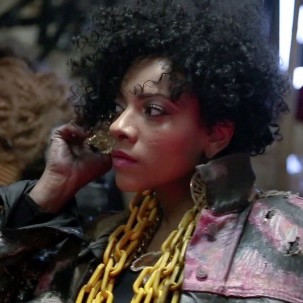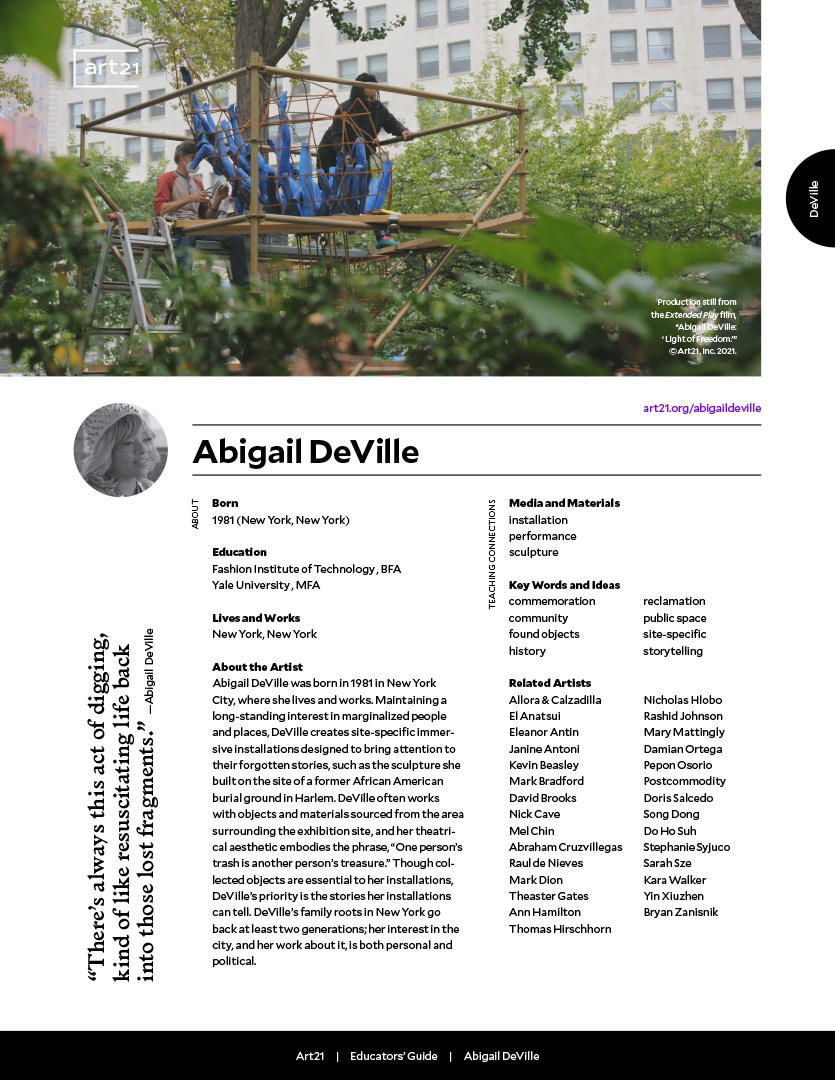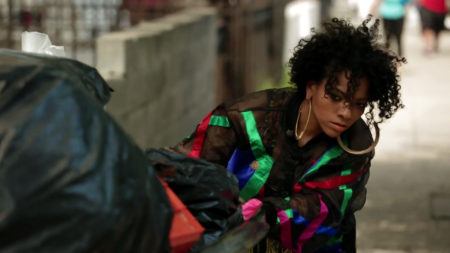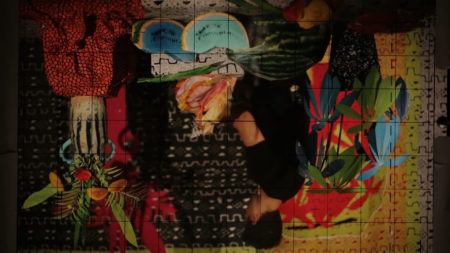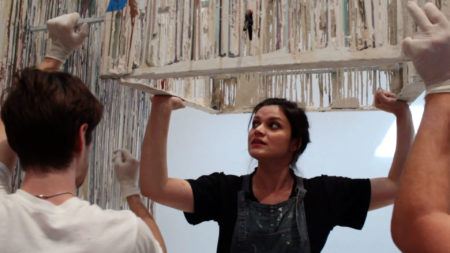Continue playing
(Time remaining: )
Play from beginning
Continue playing "{{ controller.videos[controller.getVideo(controller.currentVideo)].segmentParentTitle}}"
{{controller.videos[controller.getVideo(controller.currentVideo)].title}} has ended.
Abigail DeVille's Flair for the Dramatic
How do you get your audience to touch the art? Artist Abigail DeVille constructs the set for a premiere performance of Adrienne Kennedy’s play She Talks to Beethoven (1989) at the JACK arts center in Clinton Hill, Brooklyn. Theater director Charlotte Brathwaite describes the play’s dreamlike style and time-bending narrative: an American expatriate in 1960’s Ghana “converses” with Beethoven in early 1800s Vienna. DeVille draws parallels between the play’s temporal cross-cutting and theoretical physics—specifically the concept of wormholes, or passageways in the space-time continuum—as well as the hidden histories and absences that mark the African American experience.
To create the sculptural set titled Intersection (2014), DeVille and Brathwaite drill holes into wooden flats, linking them together to form two concentric ellipses. Acquiring cast-off materials through the Recycled Artist in Residency program in Philadelphia, DeVille describes what attracts her to the discarded: “Material already has so much information trapped inside of it. It has whatever it’s chemically made up of, its physical and chemical properties, whoever owned it, loved it, and threw it away…What can you improve on that?” In a performance set to Beethoven’s Fidelio, the actors move fluidly through the dramatically lit set, sharing the sculptural space with an equally mobile audience. “You can hold an audience captive,” marvels DeVille, who is fascinated by the possibilities a theatrical context can provide. The film also documents DeVille at work in a residency at the Studio Museum in Harlem.
More information and creditsFeaturing the installations New York at Dawn (2010), Dark Star (2010), Dark Day (2012), “If I don’t think I’m sinking, look at what a hole I’m in” (2012), Street Life: A Vortex (2012), and XXXXXXX (2013); and includes music by Ludwig van Beethoven—Egmont, Op. 84; Symphony No 3 in E-flat major, Op. 55; Coriolan Overture, Op. 62; Fidelio, Op. 72—performed by the Musopen Symphony.
Credits
Art21 New York Close Up Created & Produced by: Wesley Miller & Nick Ravich. Editor: Erin Casper. Cinematography: Amitabh Joshi & Erik Spink. Sound: Nick Ravich. Associate Producer: Ian Forster. Design & Graphics: Crux Studio, Open. Artwork: Abigail DeVille. Music: Musopen Symphony. Thanks: Hao Bai, Charlotte Brathwaite, Gabriel DeLeon, David Dempewolf, Antonio DeVille, Billy Dufala, Alec Duffy, Fern Gookin, Elizabeth Gwinn, JACK, Adrienne Kennedy, Eric N. Mack, Jason Mitja, Natalie Paul, Paul Pryce, Recycled Artist in Residency, Revolution Recovery, Studio Museum in Harlem, Lucia Thomé, Hannah Wasileski, Yuka Yokoyama, and Yi Zhao. An Art21 Workshop Production. © Art21, Inc. 2014. All rights reserved.
Art21 New York Close Up is supported, in part, by The Lambent Foundation; the New York City Department of Cultural Affairs in partnership with the City Council; The Andy Warhol Foundation for the Visual Arts; and by individual contributors.
Closed captionsAvailable in English, German, Romanian, Italian, Japanese, Korean, Chinese, Italian
Through the Art21 Translation Project, multilingual audiences from around the globe can contribute translations, making Art21 films more accessible worldwide.
Interested in showing this film in an exhibition or public screening? To license this video please visit Licensing & Reproduction.
Abigail DeVille was born in 1981 in New York, where she lives and works. Maintaining a long-standing interest in marginalized people and places, DeVille creates site-specific immersive installations designed to bring attention to these forgotten stories. DeVille often works with objects and materials sourced from the area surrounding the exhibition site. Though collected objects are essential to her installations, DeVille’s priority is the stories her installations can tell. DeVille’s family roots in New York go back at least two generations; her interest in the city, and her work about it, is both personal and political.
Performance
Carrie Mae Weems
Joan Jonas
Educators' Guide: Abigail DeVille
The questions and activities included in this guide are recommendations for incorporating Art21 films featuring Abigail DeVille into your classroom.

